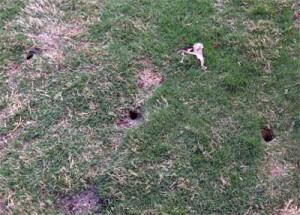Mole Crickets
How to control Mole Crickets in South Carolina?
Mole crickets reside mainly in the south and are considered the # 1 pest in turfgrass management. There are 3 types of Mole crickets in the south; the tawny mole cricket and the southern mole crickets – both were brought to the Unite States approximately 95 years ago and do not have natural enemies. There is a northern mole cricket but it is indigenous to the United States, which means it has natural predators, and rarely a problem so we won’t be discussing the northern mole cricket.
Mole cricket management requires commitment and a plan. The most important part of mole cricket management is the timing of the application. The importance of a plan is all about the timing and what type of deterrent, pesticide or organic, you use. There are various stages to mole cricket management. If pesticides are used the plan starts in the spring when the adults become active. If an organic treatment is taken the plan would be to apply in early fall and early spring before mating season. In recent years we’ve begun treating with a specific nematode which is a natural enemy of the mole cricket. This approach works best in early fall and early spring before adults mate.
We make a map of what areas show the most activity. Mole populations can vary throughout the yard. Mapping also allows us to avoid treating an entire area if the infestation is localized. Next is a monitoring of egg hatching which should be done weekly starting in May. Timing of treatment is essential – treat too late and the nymphs grow too large to manage, too early and the treatment effect is diminished by egg hatching time.
Though there are many products out there for the treatment of Mole crickets without having a plan they will mostly be ineffective. Other factors come into play such as soil moisture, if soil is too dry it shouldn’t be treated. Product selection is essential to success and must be appropriate for your selected site. Subsurface applications have been found to have the best results – which is why it’s best to have a professional landscaping company such as Beach Landscaping take on the management of mole crickets. There is then the follow up phase of the management plan. 2 weeks after the initial application we check the area(s) where it was applied. If we find crickets are still present in the treated area this does not necessarily mean the pesticide failed, it can simply indicate a very high initial cricket population. If that occurs we note it on the map. In August and
September is when surface damage is obvious. Additional treatment can occur at this point as well in hopes of stopping any further damage from adult crickets.
From reading above you can see that the eradicating of mole crickets is not a wake up today and take care of your cricket’s type of solution – it entails a plan, understanding of the biology and, most importantly, committing to it. Without this the crickets will win the battle!
Sources
http://archive.lib.msu.edu/tic/tgtre/article/1997jan1a.pdf
http://www.entsoc.org/PDF/Pubs/Periodicals/AE/AE-2002/spring/Villani-research.pdf
http://www.garden.org/subchannels/landscaping/ground?q=show&id=1859









